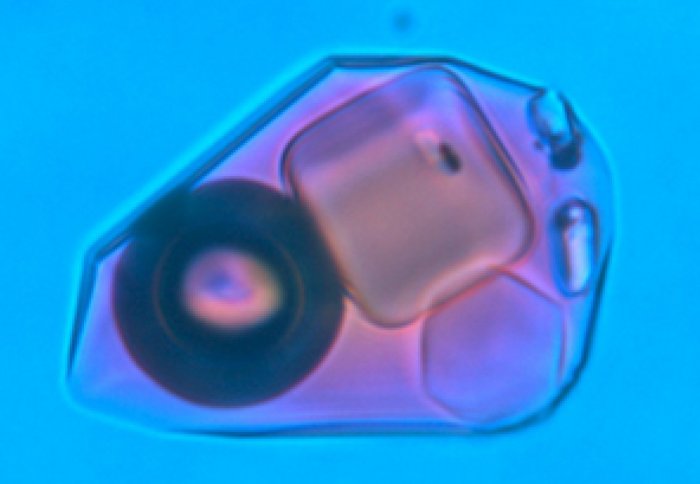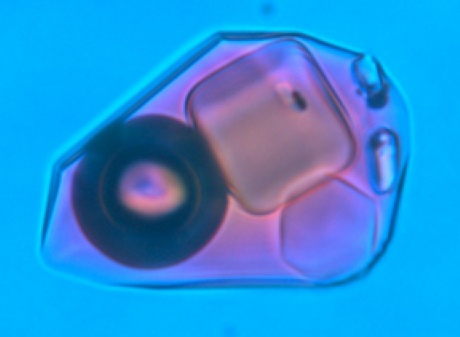January 2017 ESE Newsletter

A New Year in ESE: A new way to determine salinity in aqueous inclusions, ESE researchers are highly commended, and a geoscientist touring the US
Contents
Publications
Conferences, Lectures and Seminars
Awards
Research Activity
Workshops and Courses
Impact
Media
PhD vivas
Publications
Berndt, T. and Muxworthy, A. R. (2017). Dating Icelandic glacial floods using a new viscous remnant magnetization protocol. Geology, 45 (4). DOI: 10.1130/G38600.1.
Kenney, J. P. L., M. E., Kirby., Cuadros, J. & Weiss, D. J. (2017). A conceptual model to predict uranium removal from aqueous solutions in water–rock systems associated with low- and intermediate-level radioactive waste disposal. RSC Advances, 7, 7876.
Lu, X., Tjaden, B., Bertei, A., Li, T., Li, K., Brett, D., and Shearing, P. (2017). 3D characterization of diffusivities and its impact on mass flux and concentration overpotential in SOFC Anode. Journal of the Electrochemical Society, 164, F188–F195. DOI: 10.1149/2.0111704jes.
Nielsen, S. G., Rehkamper, M., Prytulak, J. (2017). Investigation and application of thallium isotope fractionation. Reviews in Mineralogy and Geochemistry, 82. doi.org/10.2138/rmg.2017.82.18.
Reagan, M. K., Pearce, J. A., Petronotis, K., Almeev, R., Avery, A.J., Carvallo, C., Chapman, T., Christenson, G. L., Ferre, E. C., Godard, M., Heaton, D. E., Kirchenbaur, M., Kurz, W., Kutterolf, S., Li, H., Li, Y., Michibayashi, K., Morgan, S., Nelson, W. R., Prytulak, J., Python, M., Robertson, A. H. F., Ryan, J. G., Sager, W. W., Sakuyama, T., Shervais, J., Shimzu, K., Whattam, S. A. (2017). Subduction intiation and ophilolite crust: new insights from IODP Drilling. International Geology Review, doi.org/10.1080/00206814.2016.127642.
Ryan, J., Li, Y., Reagan, M. K., Li, H., Heaton, D., Godard, M. M., Kirchenbaur, M., Whattam, S., Pearce, J., Chapman, T., Nelson, W., Prytulak, J., Shervais, J., Shimizu, K., Petronotis, K. (2017). Application of a handheld X-ray fluorescence spectrometer for real-time, high-density quantitative analysis of drilled igneous rocks and sediments during IODP Expedition 352. Chemical Geology, doi.org/10.1016/j.chemgeo.2017.01.007.
Salimzadeh, S., Paluszny, A., Zimmerman, R. W. (2017). Three-dimensional poroelastic effects during hydraulic fracturing in permeable rocks. International Journal of Solids and Structures. http://dx.doi.org/10.1016/j.ijsolstr.2016.12.008
Van Cappelle, M., Ravnås, R., Hampson, G. J. & Johnson, H. D. (2017). Depositional evolution of a progradational to aggradational, mixed-influenced deltaic succession: Jurassic Tofte and Ile formations, southern Halten Terrace, offshore Norway. Marine and Petroleum Geology, 80, 1–22. DOI:10.1016/j.marpetgeo.2016.11.013.
Wilkinson, J. J. (2017). Metastable freezing: A new method for the estimation of salinity in aqueous fluid inclusions. Economic Geology, 112, 185–193.
Conferences, Lectures and Seminars
A strong ESE contingent attended the inaugural Joint Assembly conference (January 4-6), which brought together the Volcanic and Magmatic Studies Group, the Tectonic Studies Group, and the British Geophysical Association for the first time. Hosted by the University of Liverpool the conference involved session ranging from continental break-up through to seismology and aerosols in the atmosphere. A highlight of the conference was the conference dinner, which involved street food, entertainers and dancing. Craig Magee, Jenny Collier, Julie Prytulak and Christine Bischoff attended with presentations from Matt Genge and PhD students Tom Phillips, Carl McDermott, Alex Coleman, Martin Mangler and Adamu Suleiman. MSci student Sam Hill also attended and presented his MSci research as a poster. Additionally, former ESE undergraduate Amber Madden-Nadeau presented a poster based on her 3rd year Sardinia research project with Matt Genge and Julie Prytulak. Jenny Collier, president of the BGA, was involved with the initial set-up and design of the Assembly.
Highlights of the conference include Carl McDermott winning the ‘best overall student talk’ prize for his presentation on “Using SDRs to identify the mode of breakup along South America’s magma-rich margin”
Tom Phillips was also highly commended for receiving the Ramsey Medal, a prize awarded by the TSG to the best paper emanating from a PhD, following his work on “Reactivation of intrabasement structures during rifting: A case study from offshore southern Norway”
Thomas Berndt presented a talk titled "Paleomagnetic field reconstruction from mixtures of titanomagnetites" at the Magnetic Interactions 2017 meeting in Edinburgh (January 5-6).
Rebecca Bell, Chris Jackson and PhD students Antje Lenhart and Tom Phillips attended the final meeting of the ‘MultiRift’ project in Bergen, Norway (11 January). The MultiRift project is a multi-institutional (Imperial, Bergen, Manchester), Norwegian Research Council-funded project aimed at understanding the tectono-stratigraphic development of rifts that formed in response to polyphase extension.
Chris Jackson began the first leg of his Geological Society of America (GSA) Distinguished Lecturer Tour. This leg will last two weeks (28th January-11th February), with Chris giving talks at Ohio State, Rutgers, Oklahoma, Hawaii and Colorado School of Mines. As part of the tour and on behalf of GSA, Chris has been writing a blog, chronicling the background to and preparation for the tour; wi-fi connectivity permitting, Chris will be ‘live blogging’ and tweeting (@seis_matters) whilst on the road. The second leg of the tour will take place in mid-April, with Chris planning visits to El Paso, Virginia, Oregon, Arkansas, Connecticut and Colombia.
The ESE undergraduate teaching team attended en masse the recent Geological Society Higher Education Network conference at the GeolSoc at Burlington House. Lorraine Craig presented Mike Streule’s talk ‘Student measures of teaching excellence and teacher esteem in a research intensive university: the students’ value economy in a TEF world’ and a talk by Lizzie Day and Gareth Collins entitled ‘Improving scientific writing in undergraduate geosciences degrees through peer review’. Emma Passmore presented a talk on ‘Lost in the fog: the importance of liminality and authenticity in learning tasks’. ESE delegates made a significant contribution to the day, demonstrating the breadth of teaching excellence in our department.
Adriana Paluszny of the Rock Mechanics Group gave an invited talk entitled “Accurate finite element-based modelling of fracture growth and interaction in three dimensions” at the Department of Mathematics of the University of Bergen on 23 January.
Awards
The MAGIC group is proud to announce that Julie Prytulak has been awarded the prestigious 2017 Houtermans Award from the European Association of Geochemistry for exceptional contribution to geochemistry published as a single paper or series of papers by a researcher within 12 years of the start of their PhD. The award and medal will be formally bestowed at the August Goldschmidt meeting in Paris.
Research Activity
On January 3, the Fertility Fingerprints project kicked off, fully funded by Quantum Pacific Exploration (QPX). This 3-year project, led by Jamie Wilkinson and with PDRA Matt Loader, aims to develop novel tools using the chemistry of igneous accessory minerals for early-stage assessment of porphyry exploration projects. QPX are a privately-funded greenfields mineral exploration company working in Northern Chile with a highly technical and unconventional approach to exploration. The LODE LA-ICP-MS lab is currently co-sponsored by QPX and delivers commercial analyses for the company which form a key part of their exploration workflow. QPX are keen to work with other researchers with relevant expertise, particularly in the field of geophysics - please get in touch with Jamie Wilkinson (j.wilkinson@imperial.ac.uk) if you have any interesting technology or methods that could be developed with them.
Prof. Yongsheng Zhou from the State Key Laboratory of Earthquake Dynamics, China Earthquake Administration, Beijing, gave a seminar entitled “Creep of fine-grained gabbro under dry and wet conditions” in our department on 25 January 2017. Prof. Zhou’s visit is supported by a Partnered Access Fund, as part of a collaboration with PhD students Helen Lacey and Tom Phillips, Becky Bell and Robert Zimmerman in ESE, and researchers at the University of Nottingham.
Workshops and Courses
PhD students Michael Steventon and Harya Nugraha from the Basins Research Group (BRG) organised and attended the S4SLIDE (Significance of Modern and Ancient Submarine Slope Landslides) workshop, which was held in London (23-24 January). S4SLIDE (@S4SLIDE) is part of an initiative funded by the International Geoscience Programme (IGCP) and UNESCO, focusing on facilitating the interaction of scientists, engineers, industry and government representatives, and other parties interested in submarine mass movements and their geohazard potential. The workshop focused on: (i) standardisation of the methods used to measure the key morphometric parameters of submarine landslides; (ii) creation of a global database of subaqueous landslides incorporating morphometric parameters, geophysical information and geotechnical data; and (iii) creation of an international and multidisciplinary platform to allow researchers from academia, government and industry to develop a better understanding of the expression, genesis and significance of submarine landslides.
Impact
In a paper published in Economic Geology this month, Jamie Wilkinson described a new method for determining the salinity of aqueous fluid inclusions—‘Metastable freezing’. This technique provides a means of estimating salinity in aqueous fluid inclusions, which in some cases using traditional methods, would be impossible.

30 micron fluid inclusion in quartz
Fluid inclusions - microscopic droplets of solution trapped during mineral growth - represent the only direct means to constrain the properties of paleofluids that once passed through the Earth's crust. They are archives of information such as the density of the trapped fluid, the pressure-temperature conditions under which it was trapped and, using sophisticated methods of analysis, its chemical composition. However, the first step in the investigation of their chemistry is to gain an understanding of their basic composition via microthermometry - a relatively simple technique that involves the observation of an inclusion using a petrographic microscope whilst it is frozen, rewarmed to room temperature and then heated to several hundred degrees. Earth Sciences now has a laboratory dedicated to such experiments (Room WCB14a) which can also be used for other kinds of microscopic observation of material at different temperatures. The changes that take place in fluids during this process, such as melting of ice, can be interpreted using a variety of phase diagrams to determine the major dissolved salts that may be present in the fluid and their concentration. One of the practical problems that may be encountered is the difficulty in actually observing ice melting, from which salinity estimates are made, either because of cloudy samples or extremely small inclusion size (<5 microns).
Jamie’s paper presents a brand new method for estimating salinity in such inclusions. It is based on the observation that the metastability exhibited by all inclusions as they are frozen (i.e. they have to be supercooled before ice and salt hydrate crystals nucleate) is very systematic. Because the metastable freezing point is easy to observe in fluid inclusions (the vapour bubble that they typically contain collapses or shrinks suddenly when the liquid proportion of the inclusion solidifies) this systematic behavior allows salinity to be estimated in inclusions that would have been impossible to work with using traditional methods.
The metastable behaviour turns out to have a direct analogue in processes of cloud formation during which microscopic water droplets freeze at a predictable temperature (the so-called homogeneous freezing point) below the stable freezing point for water.
Media
On January 13, Chris Jackson co-hosted ‘Undersampled Radio’, a geo-podcast regularly hosted by Matt Hall and Graham Gansalle, Chris discussed amongst many other topics, his GSA lecture tour, academic publishing trends, and the seemingly thorny issue of whether conference posters have the same kudos as talks. The podcast can be accessed here. Chris will be returning to Undersampled Radio sometime during his GSA tour.
PhD vivas
The department is pleased to announce that Thomas Berndt successfully passed his PhD viva on 6 December 2016. Congratulations Thomas!
Article text (excluding photos or graphics) © Imperial College London.
Photos and graphics subject to third party copyright used with permission or © Imperial College London.
Reporter
Press Office
Communications and Public Affairs
- Email: press.office@imperial.ac.uk
